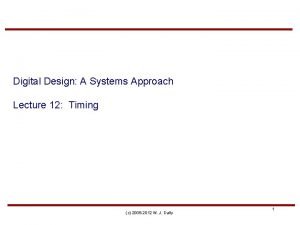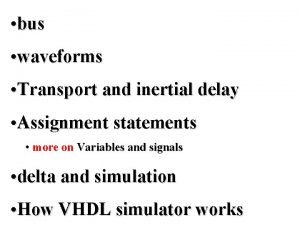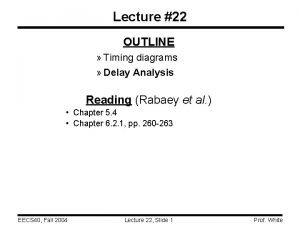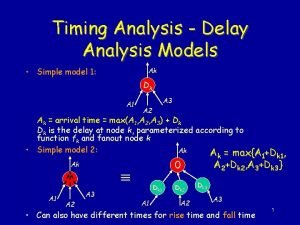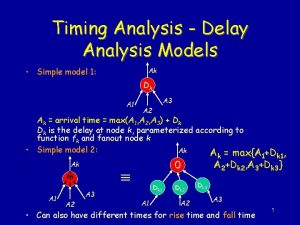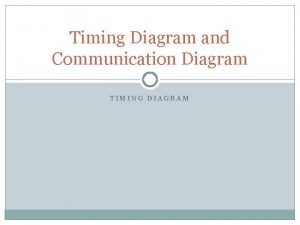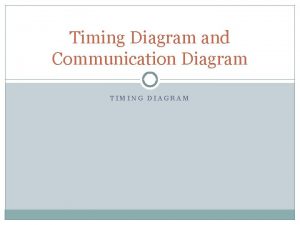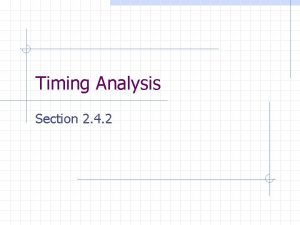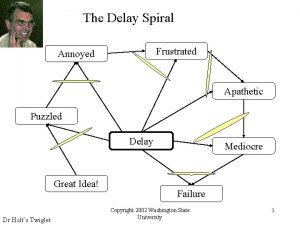Timing in Networks The delay analysis Timing in









- Slides: 9

Timing in Networks The delay analysis

Timing in Circuit Switching Assume: L Number of hops = M Per-hop processing delay = P Link propagation delay = L Transmission speed = W bit/s Message size = B bits Total Delay = total propagation + total transmission + total processing = 4 ML + B/W + (M-1)P P B/W Total Delay

Timing in Datagram Packet Switching Assume: Number of hops = M Per-hop processing delay = P Link propagation delay = L Packet transmission delay = T Message size = N packets Total Delay = total propagation + total transmission + total store&forward + total processing = ML + NT + (M-1)P T Total Delay L P

Timing in Virt. Circ. Packet Switching P Assume: Number of hops = M Per-hop processing delay = P Link propagation delay = L Packet transmission delay = T Message size = N packets Total Delay = total propagation + total transmission + total store&forward + total processing = 4 ML + NT + (M-1)T + 4(M-1)P Total Delay T P T L P

Remark n We are often interested only in the delay elapsed from the time the first bit was sent to the time the last bit was received (i. e. , we exclude the time involved in acknowledging connection termination). If this is the case, the delay will be given as follows: Circuit Switching: Delay = 3 ML + B/W + (M-1)P n Datagram packet switching: Delay = ML + NT + (M-1)P (same as before) n Virtual circuit packet switching: Delay = 3 ML + NT + (M-1)T + 3(M-1)P n

Solved Exercises Q 1: It’s 1989. Alice and Bob are 4 hops apart on a datagram packet-switched network where each link is 100 mile long. Per-hop processing delay is 5 ms. Packets are 1500 bytes long. All links have a transmission speed of 56 kbit/s (original speed of Internet backbone links in the 80 s). The speed of light in the wire is approximately 125, 000 miles/s. If Bob sends a 10 packet message to Alice, how long will it take Alice to receive the message up to the last bit (measured from the time Bob starts sending)? n Answer: We know the following: n n n Number of hops M=4, Number of packets N=10, Per-hop processing delay P=5 ms=0. 000005 s, Link propagation delay L = distance/speed of light = 100/125, 000 = 0. 0008 s, Packet size = 1500 bytes = 1500*8=12, 000 bits, Packet transmission delay T = packet size/transmission speed = 12, 000/56000 =0. 214 s. Delay = n ML + NT + (M-1)P =0. 0032 + 2. 14 + 0. 642 + 0. 000015 = 2. 785 s. Note that the total delay is dominated by the transmission delay which depends on link speed. A link with a higher transmission speed can reduce the delay dramatically.

Solved Exercises Q 2: Alice and Bob 12 years later. All is the same, except that link transmission speed now is 1 Gbit/s. How long will it take Alice to receive the message up to the last bit (measured from the time Bob starts sending)? n Answer: As before, we know the following: n n n Number of hops M=4, Number of packets N=10, Per-hop processing delay P=5 ms, Link propagation delay L = distance/speed of light = 100/125, 000 = 800 ms, Packet size = 1500 bytes = 1500*8=12, 000 bits, Packet transmission delay T = packet size/transmission speed = 12, 000/10 9 =12 ms. Delay = n ML + NT + (M-1)P =3200 + 120 + 36 + 15 = 3371 ms = 3. 371 ms. Note that the total delay is now dominated by the propagation delay which cannot be improved because it is constrained by the speed of light. Hence, it is unlikely that future technologies will significantly reduce the delay of Bob’s message at this point (unless we break the speed of light)!

Solved Exercises Q 3: Repeat Q 1 and Q 2, assuming that the network uses circuit switching instead of datagram packet switching. Bob’s message is the same length as before. n Answer: Year 1989: n n n Number of hops M=4, Message size B = 10 * 1500 * 8 =120, 000 bits (it is not packetized) Link transmission speed W = 56 kbit/s, Per-hop processing delay P=0. 000005 s, Link propagation delay L = distance/speed of light = 100/125, 000 = 0. 0008 s, Delay = n n =0. 0096 + 2. 14 + 0. 000015 = 2. 1496 s Note that the delay improved over the case of datagram packet switching for the same link speed. Why? Year 2001: Let link transmission speed be W = 1 Gbit/s Delay = n 3 ML + B/W + (M-1)P =9600 + 120 + 15 = 9735 ms = 9. 735 ms Note that the delay is worse than in the case of datagram packet switching. Why?

Observations n n With the advances in transmission speed total delays are dominated by propagation delays which are bound by the speed of light. Circuit switching adds an extra roundtrip over datagram packet switching, but eliminates store and forward delays. We have two cases: n n When links are slow, the bottleneck is transmission speed on the link. Eliminating the need to store-and-forward helps a lot. The extra roundtrip adds only negligible delay. Hence, using circuit switching results in a net reduction in delay. When links are fast, the bottleneck is propagation delay. Adding a roundtrip hurts a lot. Eliminating the need for store-and-forward saves a negligible amount of time. Hence, using circuit switching results in a net increase in delay.
